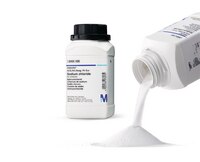104952 SupelcoPotassium chromate
for analysis EMSURE® ACS,Reag. Ph Eur
More>> for analysis EMSURE® ACS,Reag. Ph Eur Less<<Synonyms: chromic acid potassium salt
Recommended Products
Overview
| Replacement Information |
|---|
Key Spec Table
| CAS # | EC Number | Hill Formula | Chemical Formula | Molar Mass | Grade Value |
|---|---|---|---|---|---|
| 7789-00-6 | 232-140-5 | CrK₂O₄ | K₂CrO₄ | 194.2 g/mol | ACS,Reag. Ph Eur |
Pricing & Availability
| Catalogue Number | Availability | Packaging | Qty/Pack | Price | Quantity | |
|---|---|---|---|---|---|---|
| 1049520250 |
|
Plastic bottle | 250 g |
|
— | |
| 1049521000 |
|
Plastic bottle | 1 kg |
|
— |
| Description | |
|---|---|
| Catalogue Number | 104952 |
| Synonyms | chromic acid potassium salt |
| References |
|---|
| Product Information | |
|---|---|
| CAS number | 7789-00-6 |
| EC index number | 024-006-00-8 |
| EC number | 232-140-5 |
| Grade | ACS,Reag. Ph Eur |
| Hill Formula | CrK₂O₄ |
| Chemical formula | K₂CrO₄ |
| Molar Mass | 194.2 g/mol |
| HS Code | 2841 50 12 |
| Quality Level | MQ300 |
| Applications |
|---|
| Biological Information |
|---|
| Physicochemical Information | |
|---|---|
| Density | 2.73 g/cm3 |
| Melting Point | 968.3 °C |
| pH value | 8.5 - 10.0 (50 g/l, H₂O, 20 °C) |
| Bulk density | 1400 kg/m3 |
| Solubility | 637 g/l |
| Dimensions |
|---|
| Materials Information |
|---|
| Toxicological Information |
|---|
| Safety Information | |
|---|---|
| Categories of danger | carcinogenic, mutagenic, irritant, sensitizing, dangerous for the environment |
| Product Usage Statements |
|---|
| Storage and Shipping Information | |
|---|---|
| Storage | Store at +2°C to +30°C. |
| Packaging Information |
|---|
| Supplemental Information |
|---|
| Global Trade Item Number | |
|---|---|
| Catalogue Number | GTIN |
| 1049520250 | 04022536057965 |
| 1049521000 | 04022536057972 |
Documentation
Potassium chromate SDS
| Title |
|---|
Potassium chromate Certificates of Analysis
| Product Number | Packaging | Specification | Lot Number |
|---|---|---|---|
| 1049520250 | Plastic bottle | PDF Specification Document | |
| 1049521000 | Plastic bottle | PDF Specification Document |
Brochure
| Title |
|---|
| Inorganics & Solvents for classical analysis |
| More Than Sure |
| Smart Up your lab |










